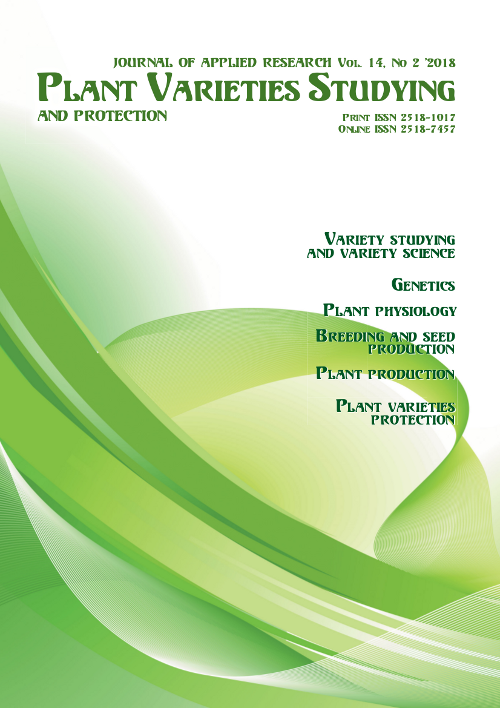Biological features of ornamental Poaceae cultivars introduced at the M. M. Hryshko National Botanical Garden of the National Academy of Sciences of Ukraine
DOI:
https://doi.org/10.21498/2518-1017.14.2.2018.134761Keywords:
morphological and biological features, seasonal rhythm of development, productivity of shoot formation and flowering, grassesAbstract
Purpose. To analyze the varietal diversity of the ornamental Poaceae collection introduced in the M. M. Hryshko National Botanical Garden of the National Academy of Sciences of Ukraine, to determine its morphobiological potential.
Methods. Introduction studies, phenological observations, morphometry, statistical processing.
Results. The cultivars diversity of ornamental grasses in the M. M. Hryshko National Botanical Garden of the National Academy of Sciences of Ukraine has been studied. Groups of cultivars for the seasonal rhythm of development (spring growth beginning, flowering and the beginning of the fruiting phase) have been selected. The study of morphological parameters of ornamental grasses made it possible to distinguish low, medium and tall cultivars in height. Among the low grasses, cultivars groups with spring and summer flowering can be identified. Medium grasses are represented by cultivars with spring, summer and autumn flowering period. Flowering shoots of more than 200 cm produce tall varieties of the genus Miscanthus. Plants of Arundo donax ‘Versicolor’ produce shoots 220.6±6.5 cm in the conditions of introduction. Tall cultivars with a spring flowering period are absent in the collection of ornamental grasses.
Conclusions. Cultivars with early (late March – early April) and medium (mid-April) period of growth are characterized by spring and early summer flowering period. Plants with late (late April – early May) period of growth are blooming in late August – early October. It was found that cultivars of genus: Festuca, Melica, Miscanthus, Molinia, Stipa, Panicum have a high ability to form shoots in the Forest-Steppe and Polissya of Ukraine. High flowering productivity was recorded for M. sinensis ‘Kleine Fontane’, M. sinensis ‘Kleine Silberspinne’, M. sinensis ‘Zebrinus’, M. sinensis ‘Apache’, Melica altissima ‘Atropurpurea’, M. altissima ‘Alba’, Molinia caerulea ‘Nana Variegata’, Stipa calamagrostis ‘Lemperg’. The selected assortment of low, medium and tall grasses with different periods of flowering and coloring of the leaves allows them to be recommended for various types of landscaping in the conditions of Ukraine.
Downloads
References
Laptev, A. A., Kotik, E. A., & Kovalenko, N. K. (1978). Introduktsiya i semenovodstvo gazonnykh trav na Ukraine [Introduction and seed-growing of lawn grasses in Ukraine]. Kyiv: Naukova dumka. [in Russian]
Leyheová, U. (2010). Trávy a kapradiny.Praga: Knižní klub.
Zheltovskaya, T. T. (2008). Dekorativnye travy v dizayne sada [Ornamental grasses in the garden design]. Moscow: Kladez Buks. [in Russian]
Hrydko, O. O. (2009). Seed productivity of the ornamental grasses in the South-East introduction conditions of Ukraine. Promyshlennaya botanika [Industrial Botany], 9, 160–163. [in Ukrainian]
Hlukhov, O. Z., & Hrydko, O. O. (2012). Introdukovani dekoratyvni zlaky v umovakh pivdennoho skhodu Ukrainy [Introduced ornamental grasses in the conditions of South-East Ukraine]. Donetsk: Sloboda. [in Ukrainian]
Alekhin, A. A., Orlova, T. G., & Komir, Z. V. (2007). Ornamental cereals in the collection of the Botanical Garden of the V. N. Karazin Kharkiv National University. In Promyslova botanika: stan ta perspektyvy rozvytku: mater. V Mizhnar. nauk. konf. [Industrial botany: the state and prospects of development: materials of V Int. Sci. Conf.] (pp. 24–26). Sept. 24–26, 2007, Donetsk, Ukraine. [in Russian]
Kudina, G. A., & Kachur, L. Yu. (2005). Introduction of ornamental cereals and perspectives of using them in Donbas. Promyshlennaya botanika [Industrial Botany], 5, 39–45. [in Russian]
Bulakh, P. E. (2010).Teoriya i metody prognozirovaniya v introduktsii rasteniy [Theory and methods for prediction in plant introduction]. Kyiv: Naukova dumka. [in Russian]
Serebryakova, T. I. (1971). Morfogenez pobegov i evolyutsiya zhiznennykh form zlakov [Morphogenesis of shoots and evolution of life forms of cereals]. Moscow: Nauka. [in Russian]
Zhmylev, P. Yu., Alekseev, Yu. V., & Karpukhina, E. A. (2005). Biomorfologiya rasteniy [Biomorphology of plants]. Moscow: Nauka. [in Russian]
Zaytsev, G. N. (1991). Matematicheskiy analiz biologicheskikh dannykh [Mathematical analysis of biological data]. Moscow: Nauka. [in Russian]
Horobets, V. F., Mashkovska, S. P., & Buidin, Yu. V. (Eds.). (2008). Kolektsiinyi fond kvitnykovo-dekoratyvnykh roslyn Natsionalnoho botanichnoho sadu im. M. M. Hryshka NAN Ukrainy. Kataloh roslyn [Collection fund of flower and ornamental plants of the M. M. Hryshko National Botanical Garden of the National Academy of Sciences of Ukraine. Catalog of plants]. Ternopil: Medobory. [in Ukrainian]
Derzhavnyi reiestr sortiv roslyn, prydatnykh dlia poshyrennia v Ukraini na 2018 rik [State Register of plant varieties suitable for cultivation in Ukraine in 2018]. (2018). Retrieved from http://sops.gov.ua/uploads/page/5af16f8a85705.pdf [in Ukrainian]
Downloads
Published
How to Cite
Issue
Section
License
Copyright (c) 2018 Ukrainian Institute for Plant Variety Examination

This work is licensed under a Creative Commons Attribution-ShareAlike 4.0 International License.
Starting in 2022, the copyright to the publication remains with the authors
Our journal abides by the CREATIVE COMMONS copyright rights and permissions for open access journals.
Authors, who are published in this journal, agree to the following conditions:
- The authors reserve the right to authorship of the work and pass the first publication right of this work to the journal under the terms of a Creative Commons Attribution License, which allows others to freely distribute the published research with the obligatory reference to the authors of the original work and the first publication of the work in this journal.
- The authors have the right to conclude separate supplement agreements that relate to non-exclusive work distribution in the form in which it has been published by the journal (for example, to upload the work to the online storage of the journal or publish it as part of a monograph), provided that the reference to the first publication of the work in this journal is included.

























 Ukrainian Institute for Plant Varieties Examination
Ukrainian Institute for Plant Varieties Examination  Селекційно-генетичний інститут
Селекційно-генетичний інститут Institute of Plant Physiology and Genetics of the National Academy of Sciences of Ukraine
Institute of Plant Physiology and Genetics of the National Academy of Sciences of Ukraine
 The National Academy of Agrarian Sciences of Ukraine
The National Academy of Agrarian Sciences of Ukraine